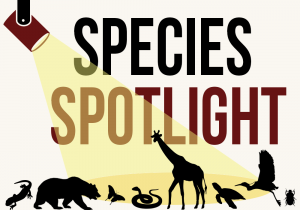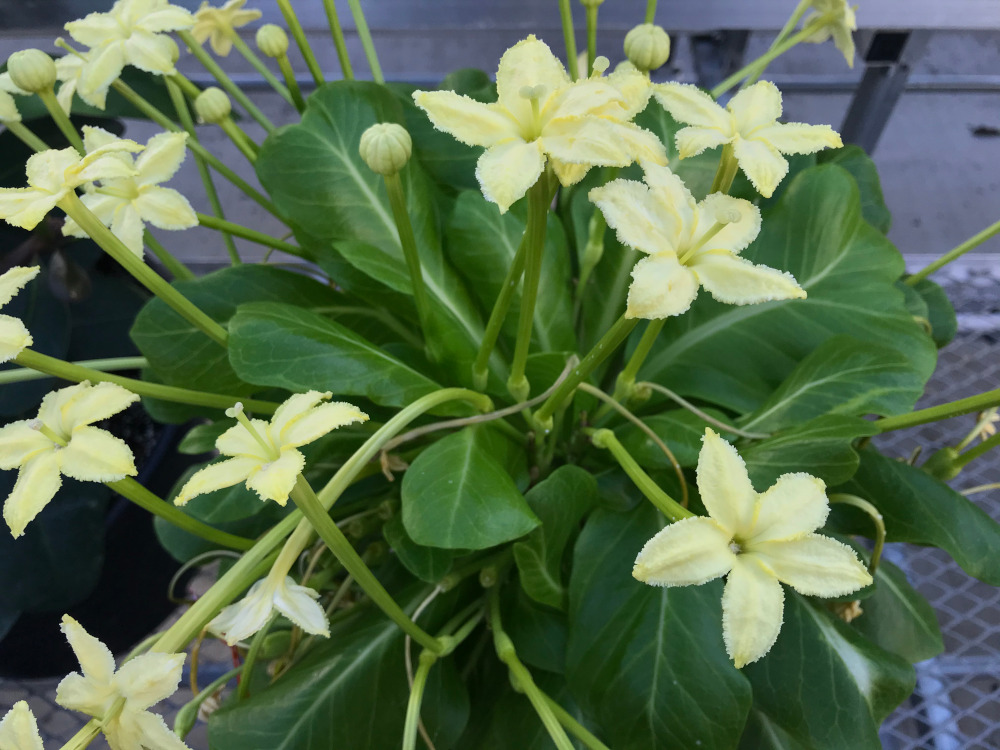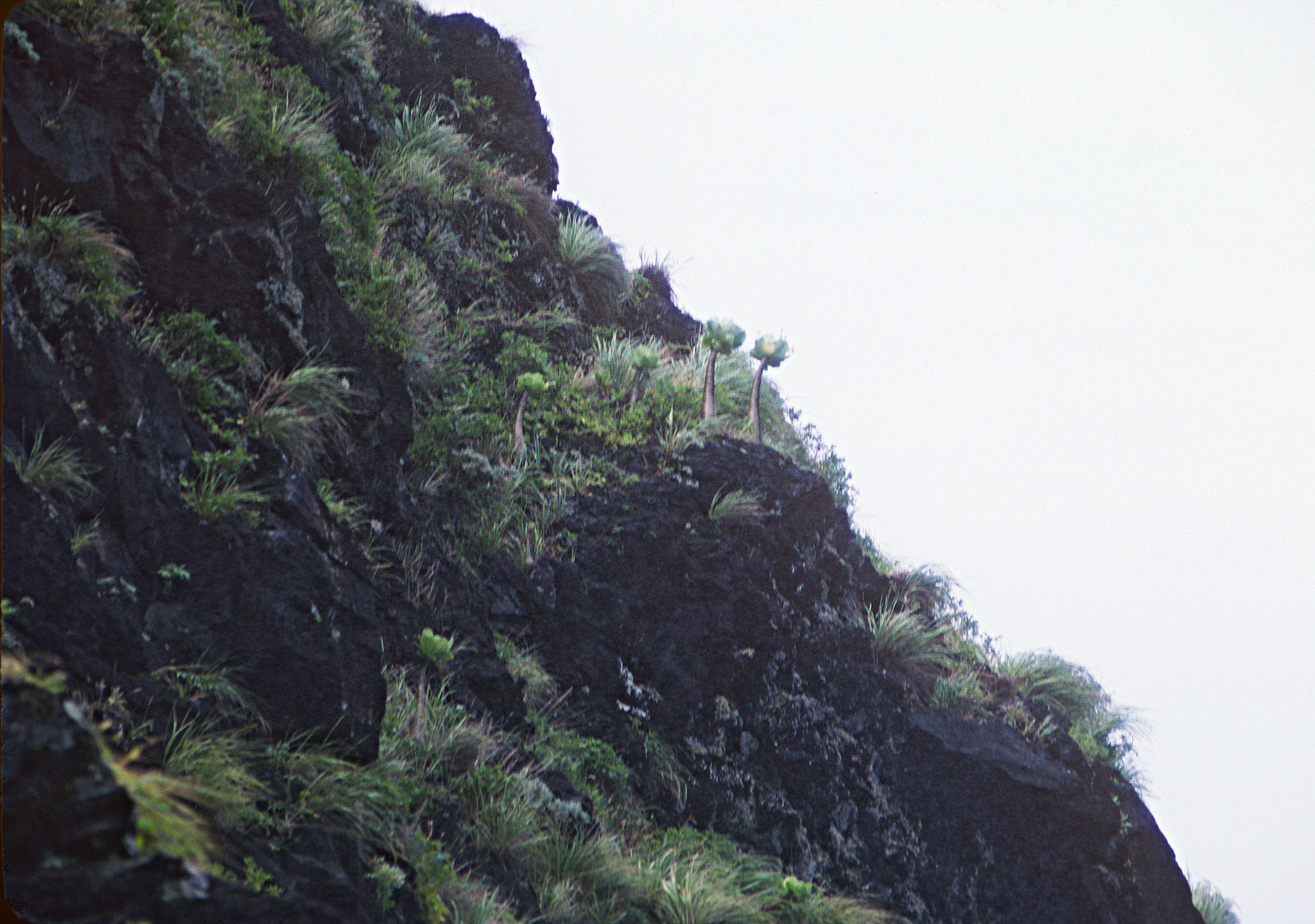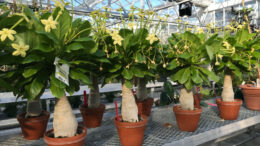 Known for growing on steep cliffs, Brighamia insignis has become an icon for plant conservation — not only in Hawai‘i but worldwide. Although it’s now extinct in the wild, more than 250 plants are maintained in collections at some 52 institutions globally, proof that people can sometimes save plants from extinction even when their habitats suffer.
Known for growing on steep cliffs, Brighamia insignis has become an icon for plant conservation — not only in Hawai‘i but worldwide. Although it’s now extinct in the wild, more than 250 plants are maintained in collections at some 52 institutions globally, proof that people can sometimes save plants from extinction even when their habitats suffer.
Species name:
Brighamia insignis, ʻālula or ʻōlulu in Hawaiian. Also known as the Hawaiian or Vulcan palm (although not a member of the palm family) and even less creatively, “cabbage on a stick.”
Description:
These caudiciform (fat-trunked) succulents grow up to 16 feet (5 meters) tall. The plants are typically single-stemmed, although the stems may branch in rare cases. The fragrant flowers, which some compare to the fragrance of violets, range in length from 3 to 5.5 inches (7-14 cm) and are yellow to pale cream, or occasionally white.

Where it’s found:
This plant is historically endemic to the Hawaiian islands of Kaua‘i and Ni‘ihau, where it grew on coastal cliff habitats between sea level and up to 1,300 feet (400 meters) in elevation.
IUCN Red List status:
The most recent IUCN Red List assessment of B. insignis, published in 2016, classified this rare plant as “critically endangered, possibly extinct in the wild,” based on its then very small population. At the time, only a single wild individual possibly remained, but it hadn’t been seen since 2014. That individual is now assumed lost. The IUCN Red List assessment will be updated in 2022 to classify the species as extinct in the wild.
Major threats:
The many factors that likely led to the extinction of B. insignis include hurricanes, landslides, and invasive plant and animal species (particularly goats that eat the plants and disturb their cliff habitats). In addition, the plants’ presumed pollinator, a type of hawkmoth, may also have gone extinct. To perpetuate the species in captivity, conservationists must now pollinate it by hand.
Notable conservation program(s) or legal protections:
Brighamia insignis has legal protection through its federal listing as endangered under the U.S. Endangered Species Act.
Although B. insignis probably no longer exists in the wild, it’s cultivated in at least 52 sites worldwide, thanks to National Tropical Botanical Garden botanists Steve Perlman and Ken Wood, who several decades ago risked their lives collecting seeds from wild plants growing on steep cliffs.

More recently, conservationists have been working to identify the most appropriate pollen donors in each institution, similar to how zoos maintain a studbook for endangered rhinos and other animals. They’re also making plans to determine how any seeds produced should be best distributed to increase the genetic diversity and improve the health of collections.
My favorite experience:
Researching various aspects of the species’ biology to help inform management has been a large part of my life for about a decade now. I studied the floral biology, breeding system, pollination ecology and ex situ genetic diversity of B. insignis for my master’s thesis in botany through the University of Hawai‘i at Mānoa in collaboration with the National Tropical Botanical Garden and Chicago Botanic Garden. I’ve continued to work with this species since I started working at NTBG as a conservation biologist in 2015.
One of the most amazing findings to date was that nectar and volatile organic compounds of the floral scent support a moth pollination syndrome in B. insignis, which has been suspected for decades based on the flowers’ color, shape and smell. These findings were particularly interesting since B. insignis is part of an adaptive radiation in the family Campanulaceae in Hawai‘i. From a single Lobelia species colonist, the group radiated into over 150 endemic species in six genera, five of which are endemic to the Hawaiian islands. The other genera, in contrast, are scentless and have nectar typical of bird-pollinated species. However, there had never been any reports of a moth visiting the flowers, and after a floral visitor study of outplantings near the known historic range of the species, no moths and only occasional non-native insect species were observed visiting B. insignis flowers.
Several years ago, though, a woman named Shellie Fielden on Maui got in touch with me and shared a video that her son, Kesh Fielden, had taken in November 2015 of a large hawkmoth visiting the flowers of his potted B. insignis plant! Although it was a non-native hawkmoth species (Agrius cingulata) it was so exciting to see and confirm that B. insignis is indeed attractive to and visited by hawkmoths.
What else do we need to understand or do to protect this species?
Before attempting to restore natural populations of B. insignis, we must manage all threats in the wild — getting rid of invasive species and stabilizing the ground from landslides. We must also make sure that any specialized pollinators in the habitats have abundant populations.
In the meantime, additional research should include confirming possible hawkmoth pollinators. One way we’re investigating this is by collecting pollen grains from entomological collections of hawkmoth specimens from Kaua‘i and identifying it to see if B. insignis pollen is found on any of the species.
Other work could include examining (in a controlled, experimental setting) whether any of the native and/or non-native hawkmoths present on Kaua‘i would likely visit B. insignis and serve as effective pollinators. Moths could be released into an enclosure with blooming plants to observe whether they will visit and function as effective pollinators.
Key research:
- Wood, J., Ballou, J.D., Callicrate, T., Fant, J.B., Griffith, M.P., Kramer, A.T., Lacy, R.C., Meyer, A., Sullivan, S., Traylor-Holzer, K., Walsh, S.K. and Havens, K. 2020. Applying the zoo model to conservation of threatened exceptional plant species. Conservation Biology, doi:10.1111/cobi.13503.
- Walsh, S.K., Pender, R.J., Junker, R.R., Daehler, C.C., Morden, C.W. and Lorence, D.H. 2019. Pollination biology reveals challenges to restoring populations of Brighamia insignis (Campanulaceae), a critically endangered plant species from Hawai‘i. Flora, 259: 151448.
- Fant, J.B., Havens, K., Kramer, A.T., Walsh, S.K., Callicrate, T., Lacy, R.C., Maunder, M., Meyer, A.H. and Smith, P.P. 2016. What to do when we can’t bank on seeds: What botanic gardens can learn from the zoo community about conserving plants in living collections. American Journal of Botany, 103 (9): 1541-1543.
![]()

